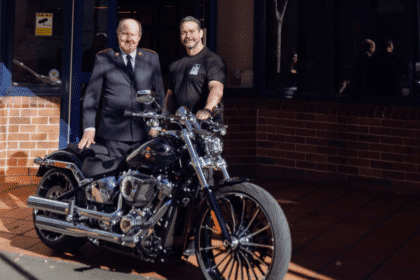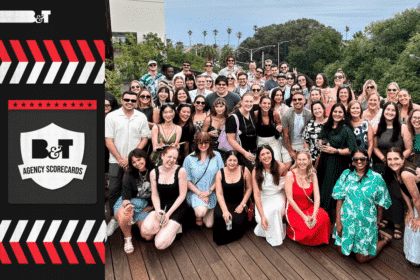A new short film documentary looking into the hidden signs included in some of the most prominent vintage advertisements, is currently available for Australian audiences in time for WorldPride.
Coded: The Hidden Love of J.C. Leyendecker, tells the story of the aforementioned illustrator, who in his time was just as well known as Steven Speilberg is today.
L-R: Kate Wickett, CEO of Sydney WorldPride, Brent Miller; CODED executive producer and P&G Global LGBTQIA+ Equality Leader; Amanda Lampe, corporate relations Director for Diageo Australia; Courtney Act, international drag queen; Kumar Venkatasubramanian, senior vice president & general manager of P&G Australia & New Zealand; and Matty Mills First Nations TV presenter and actor
But, while his work featured in newspapers and street posters advertising some of the biggest brands of the day, it was the not so obvious features of his work that have people talking decades later.
Leyendecker’s ability to slide homosexual references into his work is hard to explain in words, it’s much better explained in the documentary.
Brent Miller, an executive producer on the film, attended a special screening in Surrey Hills on Wednesday.
He told our reporter Dan Lake how he first came across the story of Leyendecker, and instantly knew he had a story to tell.
“Procter and Gamble were looking to make a film that explores the history of LGBTQ representation and advertising.
“And through that process, we rediscovered JC Leyendecker in our own archives, and quickly realised the story here was about JC and his artistry in his representation of relationships, gay relationships, and the impact that this had not only on his career, but really in future representation of LGBTQ people in advertising,” Miller said.
The producer who had flown in from New York especially for the screening said while it wasn’t their original intention to focus on an individual, he’s happy they came across Leyendecker’s work. He said the fact his story had been lost or is less widely known, largely due to his sexua orientation was disappointing.
“Now that we’re able to really appreciate his talent and his gift has been something that’s really been special from a historical perspective.
“But it’s also helped us to bring the conversation forward about representation in advertising, what the responsibilities of companies should be in that representation, and what we can all focus on doing better than before,” he said.
Researching his story wasn’t easy. Miller is hugely thankful for the passionate advertising experts whose deep knowledge of the man and the industry at the time, made the film possible.
“There really are no surviving members of the family.
“He had a brother and a sister. The brother was gay and his sister was a lesbian,” Miller said.
“And, you combine that with the fact that he had most of his artifacts burned after his death..it wasn’t easy.
Despite the hundreds of hours Miller has spent deep diving into the life of Leyendecker, he says there are still aspects of the man which remain a total mystery to him.
“One of the things I’ve always wondered is to what degree of intentionality was he doing it as a coded message?
“Or, was JC actually presenting the world through his lens in a way that other people hadn’t necessarily seen before?
“I don’t know the answer to that question.”
“Fashion illustration was very much two dimensional, very much a cardboard cutout of who people were. And he was able to add a depth to that, you could see there was a body underneath those clothes,” he said.
Leyendecker’s ability to homo-eroticsise advertising imagery wasn’t his only gift.
He’s also responsible for the first modern depiction of how we see the man whose job it is to give gifts, Santa.
“He was the first person to ever depict Santa as a jolly round man in a red suit, the image that became the standard for Santa Claus around the world today.
“So if you think about the power that he had, through his paintbrush, to imagine culture, and how people viewed the world, it was absolutely tremendous,” Miller said.
Miller said representation of the gay community is ever changing, but that’s how it should be.
“We often underestimate the value that advertising can have in reflecting culture, and reflecting or giving people the opportunity to see people like themselves.”
You know, as a young gay man, when I grew up, there was no depiction of LGBTQ culture.
In fact, the only representation I saw would have been in the height of the AIDS epidemic, which would have equated being gay to death.”
It makes you sit back and think about the role that we have as companies in creating those depictions. And the importance of doing that responsibly and ethically, without stereotyping without shortcutting.
“Because the images that we put out, not only have an impact on how the world sees us, but on how we see each other. And it’s an incredibly important responsibility,” he said.
Miller said the most important thing advertisers can do to make sure they get their message right, is to do their homework.
“Go deep and make sure that you’re really getting that insight clear. Because then the reason you’re telling the story is so much more evident to the person that’s receiving it.”
Coded: The Hidden Love of J.C. Leyendecker is currently available on Paramount Plus.









